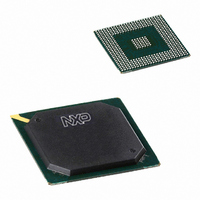PNX1501E,557 NXP Semiconductors, PNX1501E,557 Datasheet - Page 758

PNX1501E,557
Manufacturer Part Number
PNX1501E,557
Description
IC MEDIA PROC 266MHZ 456-BGA
Manufacturer
NXP Semiconductors
Datasheet
1.PNX1502EG557.pdf
(828 pages)
Specifications of PNX1501E,557
Applications
Multimedia
Core Processor
TriMedia
Controller Series
Nexperia
Interface
I²C, 2-Wire Serial
Number Of I /o
61
Voltage - Supply
1.14 V ~ 1.26 V
Operating Temperature
0°C ~ 85°C
Mounting Type
Surface Mount
Package / Case
456-BGA
Lead Free Status / RoHS Status
Lead free / RoHS Compliant
Program Memory Type
-
Ram Size
-
Other names
935274728557
PNX1501E
PNX1501E
PNX1501E
PNX1501E
Available stocks
Company
Part Number
Manufacturer
Quantity
Price
Company:
Part Number:
PNX1501E,557
Manufacturer:
NXP Semiconductors
Quantity:
10 000
- Current page: 758 of 828
- Download datasheet (8Mb)
1. Introduction
The PNX15xx Series chip contains an I
peripherals including consumer electronic appliances, video image processing
equipment, and miniature cards. The IIC module supports bi-directional data transfer
between master and slave in slow and fast speeds as well as multiple master and
slave modes. Arbitration between simultaneously transmitting masters can be
maintained without corruption of serial data on the bus. Serial clock synchronization
allows devices with different bit rates to communicate via one serial bus, and it can be
used as a handshake mechanism to suspend and resume serial transfer. The IIC
hardware architecture and software protocol is simple and versatile.
The on-chip IIC module provides a serial interface that meets the I
specification and supports all transfer modes to and from the I
following functionality:
The I
controlling the bus can be connected to it. Because more than one master could try to
initiate a data transfer at the same time, a collision detection scheme is used to
arbitrate between the multiple masters. If two or more masters attempt to transfer
information onto the bus, the first to produce a ‘one’ when the other produces a ‘zero’
will detect the collision and back off transferring information.
The clock signals during arbitration are a synchronized combination of the clocks
generated by the masters using the wired-AND connection to the SCL line. Two
wires, SDA serial data) and SCL (serial clock), carry information between the devices
connected to the I
Each device can operate as either a transmitter or receiver, depending on the
function of the device. In addition to transmitters and receivers, devices can also be
considered as masters or slaves when performing data transfers. A master is the
device which initiates a data transfer on the bus and generates the clock signals to
permit that transfer. Any device addressed by a master is considered a slave.
•
•
•
•
•
Chapter 25: I
PNX15xx Series Data Book – Volume 1 of 1
Rev. 3 — 17 March 2006
Both normal and fast modes up to 400 kHz.
32-bit word access from the CPU; no buffering is supported.
Generation of interrupts on I
Four modes of operation: master transmitter and receiver, slave transmitter and
receiver.
STO bit and the actual addresses of the Special Function Registers (SFRs).
2
C bus is a multi-master bus. This means that more than one device capable of
2
C bus.
2
2
C Interface
C state change
2
C module which interfaces with a variety of
2
Product data sheet
C bus. It supports the
2
C bus
Related parts for PNX1501E,557
Image
Part Number
Description
Manufacturer
Datasheet
Request
R
Part Number:
Description:
Manufacturer:
NXP Semiconductors
Datasheet:
Part Number:
Description:
Digital Signal Processors & Controllers (DSP, DSC) MEDIA PROCESSOR PNX15XX/266MHZ
Manufacturer:
NXP Semiconductors
Datasheet:

Part Number:
Description:
IC MEDIA PROC 266MHZ 456-BGA
Manufacturer:
NXP Semiconductors
Datasheet:
Part Number:
Description:
NXP Semiconductors designed the LPC2420/2460 microcontroller around a 16-bit/32-bitARM7TDMI-S CPU core with real-time debug interfaces that include both JTAG andembedded trace
Manufacturer:
NXP Semiconductors
Datasheet:

Part Number:
Description:
NXP Semiconductors designed the LPC2458 microcontroller around a 16-bit/32-bitARM7TDMI-S CPU core with real-time debug interfaces that include both JTAG andembedded trace
Manufacturer:
NXP Semiconductors
Datasheet:
Part Number:
Description:
NXP Semiconductors designed the LPC2468 microcontroller around a 16-bit/32-bitARM7TDMI-S CPU core with real-time debug interfaces that include both JTAG andembedded trace
Manufacturer:
NXP Semiconductors
Datasheet:
Part Number:
Description:
NXP Semiconductors designed the LPC2470 microcontroller, powered by theARM7TDMI-S core, to be a highly integrated microcontroller for a wide range ofapplications that require advanced communications and high quality graphic displays
Manufacturer:
NXP Semiconductors
Datasheet:
Part Number:
Description:
NXP Semiconductors designed the LPC2478 microcontroller, powered by theARM7TDMI-S core, to be a highly integrated microcontroller for a wide range ofapplications that require advanced communications and high quality graphic displays
Manufacturer:
NXP Semiconductors
Datasheet:
Part Number:
Description:
The Philips Semiconductors XA (eXtended Architecture) family of 16-bit single-chip microcontrollers is powerful enough to easily handle the requirements of high performance embedded applications, yet inexpensive enough to compete in the market for hi
Manufacturer:
NXP Semiconductors
Datasheet:

Part Number:
Description:
The Philips Semiconductors XA (eXtended Architecture) family of 16-bit single-chip microcontrollers is powerful enough to easily handle the requirements of high performance embedded applications, yet inexpensive enough to compete in the market for hi
Manufacturer:
NXP Semiconductors
Datasheet:
Part Number:
Description:
The XA-S3 device is a member of Philips Semiconductors? XA(eXtended Architecture) family of high performance 16-bitsingle-chip microcontrollers
Manufacturer:
NXP Semiconductors
Datasheet:

Part Number:
Description:
The NXP BlueStreak LH75401/LH75411 family consists of two low-cost 16/32-bit System-on-Chip (SoC) devices
Manufacturer:
NXP Semiconductors
Datasheet:

Part Number:
Description:
The NXP LPC3130/3131 combine an 180 MHz ARM926EJ-S CPU core, high-speed USB2
Manufacturer:
NXP Semiconductors
Datasheet:

Part Number:
Description:
The NXP LPC3141 combine a 270 MHz ARM926EJ-S CPU core, High-speed USB 2
Manufacturer:
NXP Semiconductors

Part Number:
Description:
The NXP LPC3143 combine a 270 MHz ARM926EJ-S CPU core, High-speed USB 2
Manufacturer:
NXP Semiconductors











